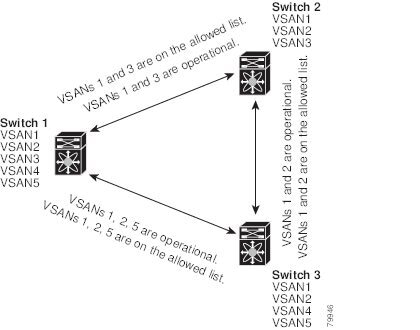In case of TE ports, the VSAN will in be initializing state when VSAN
is coming up on that interface and when peers are in negotiating phase. Once
the handshake is done, VSAN will be moved to up state in the successful case,
and isolated state in the case of failure. Device Manager will show the port
status as amber during initializing state and it will be green once VSANs are
up.
This example shows the trunk VSAN states of a TE port:
switch# show interface fc2/15
fc2/15 is trunking
Hardware is Fibre Channel, SFP is short wave laser w/o OFC (SN)
Port WWN is 20:4f:00:0d:ec:6d:2b:40
Peer port WWN is 20:0a:00:0d:ec:3f:ab:80
Admin port mode is auto, trunk mode is on
snmp link state traps are enabled
Port mode is TE
Port vsan is 1
Speed is 2 Gbps
Rate mode is dedicated
Transmit B2B Credit is 16
Receive B2B Credit is 250
B2B State Change Number is 14
Receive data field Size is 2112
Beacon is turned off
Trunk vsans (admin allowed and active) (1,100-101,1101,1163-1166,1216,2172,2182-2183)
Trunk vsans (up) (1,1101,1163-1166,1216,2172,2182-2183)
Trunk vsans (isolated) (100-101)
Trunk vsans (initializing) ()
In case of TF ports, after the handshake, one of the allowed VSANs will
be moved to the up state. All other VSANs will be in initializing state even
though the handshake with the peer is completed and successful. Each VSAN will
be moved from initializing state to up state when a server or target logs in
through the trunked F or NP ports in the corresponding VSAN.

Note
|
In case of TF or TNP ports, the Device Manager will show the port
status as amber even after port is up and there is no failure. It will be
changed to green once all the VSAN has successful logins.
|
This example shows a TF port information after the port
is in the up state:
sw7# show interface fc1/13
fc1/13 is trunking (Not all VSANs UP on the trunk)
Hardware is Fibre Channel, SFP is short wave laser w/o OFC (SN)
Port WWN is 20:0d:00:0d:ec:6d:2b:40
Admin port mode is FX, trunk mode is on
snmp link state traps are enabled
Port mode is TF
Port vsan is 1
Speed is 4 Gbps
Rate mode is shared
Transmit B2B Credit is 16
Receive B2B Credit is 32
Receive data field Size is 2112
Beacon is turned off
Trunk vsans (admin allowed and active) (1,100-101,1101,1163-1166,1216,2172,2182-2183)
Trunk vsans (up) (1)
Trunk vsans (isolated) ()
Trunk vsans (initializing) (1101,1163-1166,1216,2172,2182)
This example shows the TF port information when a server
logs in on noninternal FLOGI VSAN. VSAN 2183 is moved to the up state when the
server logs in to VSAN 2183.
w7# show interface fc1/13
fc1/13 is trunking (Not all VSANs UP on the trunk)
Hardware is Fibre Channel, SFP is short wave laser w/o OFC (SN)
Port WWN is 20:0d:00:0d:ec:6d:2b:40
Admin port mode is FX, trunk mode is on
snmp link state traps are enabled
Port mode is TF
Port vsan is 1
Speed is 4 Gbps
Rate mode is shared
Transmit B2B Credit is 16
Receive B2B Credit is 32
Receive data field Size is 2112
Beacon is turned off
Trunk vsans (admin allowed and active) (1,100-101,1101,1163-1166,1216,2172,2
182-2183)
Trunk vsans (up) (1,2183)
Trunk vsans (isolated) ()
Trunk vsans (initializing) (1101,1163-1166,1216,2172,2182)








 Feedback
Feedback